
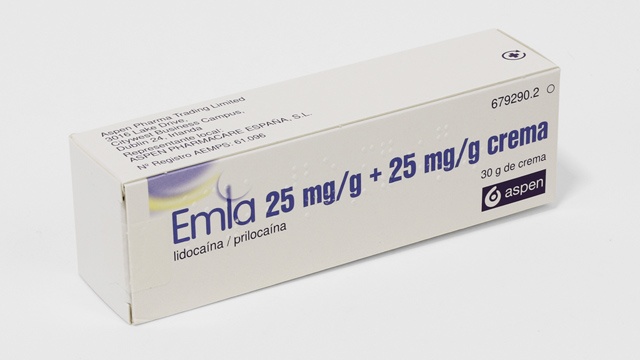
ЕМЛА 25 мг/г + 25 мг/г КРЕМ

Запитайте лікаря про рецепт на ЕМЛА 25 мг/г + 25 мг/г КРЕМ

Інструкція із застосування ЕМЛА 25 мг/г + 25 мг/г КРЕМ
Введення
Опис: Інформація для користувача
EMLA 25 мг/г + 25 мг/г крем
лідокаїн/прілокаїн
Всією увагою прочитайте цю брошуру перед тим, як почати використовувати цей лікарський засіб, оскільки вона міститьважливу інформацію для вас.
- Збережіть цю брошуру, оскільки вам може знадобитися знову її прочитати.
- Якщо у вас виникли питання, проконсультуйтеся з вашим лікарем або фармацевтом.
- Цей лікарський засіб призначений тільки вам, і його не слід давати іншим людям, навіть якщо вони мають такі самі симптоми, як у вас, оскільки це може їм нашкодити.
- Якщо ви відчуваєте побічні ефекти, проконсультуйтеся з вашим лікарем або фармацевтом, навіть якщо це побічні ефекти, які не вказані в цій брошурі. Див. розділ 4.
Зміст опису
- Що таке EMLA і для чого він використовується
- Що вам потрібно знати перед тим, як почати використовувати EMLA
- Як використовувати EMLA
- Можливі побічні ефекти
- Зберігання EMLA
- Зміст упаковки та додаткова інформація
1. Що таке EMLA і для чого він використовується
EMLA містить два активні речовини - лідокаїн і прілокаїн. Вони належать до групи лікарських засобів, званих місцевими анестетиками.
EMLA діє тим, що тимчасово знеболює поверхню шкіри. Його наносять на шкіру перед деякими медичними процедурами. Він допомагає зупинити біль у шкірі; однак, ви можете продовжувати відчувати відчуття, такі як тиск і доторк.
Дорослі, підлітки та діти
Його можна використовувати для знеболювання шкіри перед:
- Введенням голки (наприклад, якщо вам роблять ін'єкцію або проводять аналіз крові).
- Малою хірургією на шкірі.
Дорослі та підлітки
Його також можна використовувати:
- Для знеболювання геніталій перед:
- Введенням ін'єкції.
- Медичними процедурами, такими як видалення бородавок.
Використання EMLA на геніталіях повинно проводитися під наглядом лікаря або медсестри.
Дорослі
Його також можна використовувати для знеболювання шкіри перед:
- Очищенням або видаленням пошкодженої шкіри з виразок на ногах.
2. Що вам потрібно знати перед тим, як почати використовувати EMLA
Не використовувати EMLA
- якщо ви алергічні на лідокаїн або прілокаїн,інші місцеві анестетики подібного типу або на будь-який інший компонент цього лікарського засобу (перелічені в розділі 6).
Попередження та обережність
Проконсультуйтеся з вашим лікарем або фармацевтом перед тим, як почати використовувати EMLA
- якщо ви або ваш дитина маєте рідкісну спадкову метаболічну розладу, який впливає на кров, званий "дефіцит глюкози-6-фосфатдегідрогенази".
- якщо ви або ваш дитина маєте розлад рівнів пігменту в крові, званий "метгемоглобінемія".
- не використовувати EMLA на ділянках зі шкірними висипаннями, порізами, подряпинами або відкритими ранами, за винятком виразок на ногах. Якщо у вас виникли такі проблеми, проконсультуйтеся з вашим лікарем або фармацевтом перед тим, як використовувати крем.
- якщо ви або ваш дитина маєте розлад шкіри з свербінням, званий "атопічний дерматит", може бути достатнім коротший час застосування. Час застосування понад 30 хвилин може збільшити ризик місцевих реакцій на шкірі (див. також розділ 4 "Можливі побічні ефекти").
- якщо ви приймаєте лікування лікарськими засобами для порушення серцевого ритму (антиаритмічні засоби класу III, такі як аміодарон). У цьому випадку лікар буде контролювати вашу серцеву діяльність.
Через потенційно більшу абсорбцію на свіжо голеній шкірі важливо дотримуватися рекомендованої дози, поверхні шкіри та часу застосування.
Уникайте контакту EMLA з очима, оскільки це може викликати подразнення та хімічні опіки очей. Якщо випадково він потрапить у ваше око, ви повинні миттєво промити його теплою водою або фізіологічним розчином (розчином хлориду натрію). Будьте обережні, щоб нічого не наносити на око, поки воно знову не стане чутливим.
Дітей потрібно пильно спостерігати під час використання EMLA на будь-якій частині тіла, щоб уникнути потрапляння EMLA в очі.
Не слід наносити EMLA на пошкоджений барабанний апарат.
Коли ви використовуєте EMLA перед вакцинацією живими вакцинами (наприклад, вакциною проти туберкульозу), знову відвідайте вашого лікаря або медсестру після періоду, необхідного для спостереження за результатом вакцинації.
Діти та підлітки
У немовлят та новонароджених молодших 3 місяців часто спостерігається "метгемоглобінемія", тимчасове та без клінічного значення збільшення рівнів пігменту в крові, протягом 12 годин після застосування EMLA.
Клінічні дослідження не змогли підтвердити ефективність EMLA при взятті крові з п'яти немовлят або для забезпечення адекватної анестезії під час обрізання.
EMLA не слід застосовувати на слизових оболонках геніталій (наприклад, у вагіні) дітей (молодших 12 років) через відсутність достатніх даних про абсорбцію активних речовин.
EMLA не слід використовувати у дітей молодших 12 місяців, які одночасно приймають лікування іншими лікарськими засобами, які впливають на рівні пігменту "метгемоглобін" (наприклад, сульфонамідами, див. також розділ 2 "Використання EMLA з іншими лікарськими засобами").
EMLA не слід використовувати у передчасно народжених дітей.
Використання EMLA з іншими лікарськими засобами
Повідомте вашого лікаря або фармацевта, якщо ви використовуєте або приймаєте, приймали раніше або можете використовувати інші лікарські засоби, включаючи ті, які придбані без рецепта, та лікарські засоби на основі рослин. Це тому, що EMLA може впливати на дію інших лікарських засобів, а інші лікарські засоби можуть мати вплив на EMLA.
Особливо повідомте вашого лікаря або фармацевта, якщо ви або ваш дитина приймали最近 або отримували лікування одним з таких лікарських засобів:
- Лікарські засоби, використовувані для лікування інфекцій, званих "сульфонамідами" та нітрофурантоніном.
- Лікарські засоби, використовувані для лікування епілепсії, званих фенітоїном та фенобарбіталом.
- Інші місцеві анестетики.
- Лікарські засоби для лікування аритмій серця, таких як аміодарон.
- Циметидин або бета-блокатори, які можуть збільшувати рівні лідокаїну в крові. Ця взаємодія не має клінічного значення при короткочасному лікуванні EMLA у рекомендованих дозах.
Вагітність, лактація та фертильність
Якщо ви вагітні або перебуваєте у період лактації, вважаєте, що можете бути вагітною або плануєте завагітніти, проконсультуйтеся з вашим лікарем або фармацевтом перед тим, як використовувати цей лікарський засіб.
Окказіональне використання EMLA під час вагітності малоймовірно матиме будь-який негативний вплив на плід.
Активні речовини EMLA (лідокаїн та прілокаїн) виділяються у грудне молоко. Однак, кількість такої мала, що загалом не становить ризику для дитини.
Дослідження на тваринах показали, що не існує порушення фертильності у чоловіків та жінок.
Відновлення та використання машин
EMLA не впливає на здатність керувати транспортними засобами та використовувати машини або цей вплив є незначним, коли його використовують у рекомендованих дозах.
EMLA містить гідроксістеарат макроголгліцеролу
Цей лікарський засіб може викликати реакції на шкірі, оскільки містить гідроксістеарат макроголгліцеролу.
3. Як використовувати EMLA
Слідуйте точно інструкціям щодо застосування цього лікарського засобу, вказаним вашим лікарем, фармацевтом або медсестрою. У разі сумнівів проконсультуйтеся з вашим лікарем, фармацевтом або медсестрою.
Використання EMLA
- Місце нанесення крему, кількість, яку потрібно використовувати, та час, протягом якого потрібно його наносити, залежать від того, для чого він використовується.
- Ваш лікар, фармацевт або медсестра нанесуть крем або покажуть вам, як це зробити самостійно.
- Коли EMLA використовується на геніталіях, лікар або медсестра повинні наглядати за його застосуванням.
Не використовувати EMLA на таких ділянках:
- Порізи, подряпини або відкриті рани, за винятком виразок на ногах.
- Ділянки зі шкірними висипаннями або екземою.
- Очі або їхнє найближче оточення.
- Всередину носа, вуха або рота.
- У анус.
- На геніталіях дітей.
Особи, які часто наносять або знімають крем, повинні уникати контакту, щоб запобігти появі гіперчутливості.
Захисний покрив труби проколюється шляхом натискання кришечки на нього.
Використання на шкірі перед малими процедурами (наприклад, введенням голки або малими хірургічними втручаннями на шкірі):
- Нанесіть товстий шар крему на шкіру. Ваш лікар, фармацевт або медсестра покажуть вам, де його наносити.
- Потім накрийте крем плівкою [прозорим пластиком]. Її знімають саме перед початком процедури. Якщо ви наносите крем самостійно, переконайтеся, що ваш лікар, фармацевт або медсестра надали вам плівки.
- Рекомендована доза для дорослих та підлітків старших 12 років становить 2 г (грами).
- У дорослих та підлітків старших 12 років нанесіть крем за至少 60 хвилин до процедури (окрім випадків, коли крем наноситься на геніталії). Однак не наносіть його більш ніж за 5 годин до процедури.
- У дітей кількість використовуваного EMLA та час його застосування залежать від віку дитини. Ваш лікар, медсестра або фармацевт покажуть вам, яку кількість потрібно використовувати та коли його наносити.
Коли ви наносите крем самостійно, дуже важливо слідувати наступним інструкціям:
- Натисніть на трубку, щоб нанести необхідну кількість крему на шкіру в місці проведення процедури (наприклад, там, де буде введена голка). Лінія крему довжиною близько 3,5 см з трубки об'ємом 30 г відповідає 1 г крему. Не розтирайте крем.

- Відокреміть паперову частину від "центрального різку" неадгезивної сторони плівки (залишивши паперову рамку).
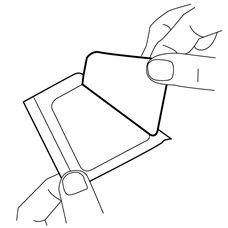
- Зніміть захисний покрив з адгезивної сторони плівки.
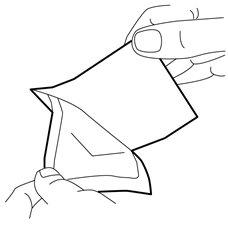
- Аккуратно помістіть плівку на нанесений крем. Не розтирайте крем під плівкою.
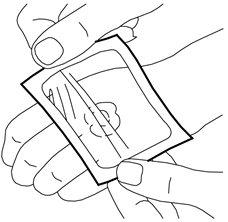
- Зніміть паперову підтримку. Аккуратно розгладьте краї плівки. Потім залиште її на місці протягом至少 60 хвилин, якщо шкіра не пошкоджена. Крем не слід залишати на місці більш ніж 60 хвилин у дітей молодших 3 місяців або більш ніж 30 хвилин у дітей з захворюванням шкіри, яке супроводжується свербінням, званим "атопічний дерматит". Якщо крем наноситься на геніталії або на виразки, можна використовувати коротші часи застосування, як описано нижче.
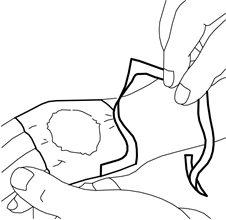
- Ваш лікар або медсестра зніме плівку та видалить крем саме перед проведенням медичної процедури (наприклад, саме перед введенням голки).
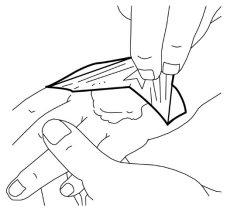
Використання на великих ділянках свіжо голеної шкіри перед амбулаторними процедурами (наприклад, депіляцією):
Рекомендована доза становить 1 г крему на кожну ділянку шкіри розміром 10 см² (10 квадратних сантиметрів), нанесеного під плівкою протягом 1-5 годин. EMLA не слід застосовувати на ділянку свіжо голеної шкіри розміром понад 600 см² (600 квадратних сантиметрів, наприклад, 30 см на 20 см). Максимальна доза становить 60 г.
Використання на шкірі перед стаціонарними процедурами (наприклад, трансплантацією шкіри), які вимагають більш глибокої місцевої анестезії:
- EMLA можна використовувати таким чином у дорослих та підлітків старших 12 років.
- Рекомендована доза становить 1,5-2 г крему на кожну ділянку шкіри розміром 10 см² (10 квадратних сантиметрів).
- Крем наноситься під окулювальний бинт протягом 2-5 годин.
Використання на шкірі для видалення бородавок, званих "молуско":
- EMLA можна використовувати у дітей та підлітків, які страждають захворюванням шкіри, яке супроводжується свербінням, званим "атопічний дерматит".
- Рекомендована доза залежить від віку дитини та використовується протягом 30-60 хвилин (30 хвилин, якщо пацієнт має атопічний дерматит). Ваш лікар, медсестра або фармацевт покажуть вам, яку кількість крему потрібно нанести.
Використання на шкірі геніталій перед введенням ін'єкцій місцевої анестезії
- EMLA можна використовувати таким чином лише у дорослих та підлітків старших 12 років.
- Рекомендована доза становить 1 г крему (1-2 г на шкірі геніталій жінок) на кожну ділянку шкіри розміром 10 см² (10 квадратних сантиметрів).
- Крем наноситься під окулювальний бинт. Його залишають на місці протягом 15 хвилин на шкірі геніталій чоловіків та протягом 60 хвилин на шкірі геніталій жінок.
Використання на геніталіях перед малими хірургічними процедурами (видаленням бородавок)
- EMLA можна використовувати таким чином лише у дорослих та підлітків старших 12 років.
- Рекомендована доза становить 5-10 г крему протягом 10 хвилин. Не використовують окулювальний бинт. Медичну процедуру слід розпочинати негайно.
Використання на виразках на ногах перед очищенням або видаленням пошкодженої шкіри
- Рекомендована доза становить 1-2 г на кожну ділянку шкіри розміром 10 см², до 10 г максимум.
- Крем наноситься під окулювальний бинт, наприклад, прозорим пластиком. Його залишають на місці протягом 30-60 хвилин перед очищенням виразки. Видаліть крем ватним тампоном та розпочніть очищення негайно.
- EMLA можна використовувати перед очищенням виразок на ногах до 15 разів протягом 1-2 місяців.
- Трубка EMLA призначена для одного використання, коли її використовують на виразках на ногах: Трубку з будь-яким залишковим вмістом слід викидати після лікування кожного пацієнта.
Якщо ви використовуєте більше EMLA, ніж потрібно
Якщо ви використовуєте більше EMLA, ніж ваш лікар, фармацевт або медсестра призначили, негайно зверніться до одного з них, навіть якщо ви не відчуваєте симптомів.
Нижче перелічені симптоми, які можуть виникнути, якщо ви використовуєте надмірну кількість EMLA. Ці симптоми малоймовірно виникнуть, якщо ви слідуєте рекомендаціям щодо використання EMLA.
- Чуття головокружіння або безсоння.
- Поколювання шкіри навколо рота та оніміння язика.
- Порушення смаку.
- Затьмарення зору.
- Шум у вухах.
- Існує також ризик "метгемоглобінемії" (проблеми з рівнями пігменту в крові). Цей ризик вищий, коли приймаються певні лікарські засоби одночасно. Якщо це трапляється, шкіра набуває синювато-сірий колір через нестачу кисню.
У важких випадках передозування симптоми можуть включати судоми, низький кров'яний тиск, повільне дихання, зупинку дихання та порушення серцевого ритму. Ці ефекти можуть бути потенційно смертельними.
У разі передозування або випадкового прийому лікарського засобу зверніться до Токсикологічної служби. Телефон 91 562 04 20.
Якщо у вас виникли питання щодо використання цього лікарського засобу, зверніться до вашого лікаря, фармацевта або медсестри.
4. Можливі побічні ефекти
Як і всі лікарські засоби, цей лікарський засіб може викликати побічні ефекти, хоча не всі люди їх відчувають.
Зверніться до свого лікаря або фармацевта, якщо будь-який з наступних побічних ефектів викликає у вас дискомфорт або не здається, що вони зникнуть. Повідомте своєму лікареві про будь-що інше, що робить вас почуватися погано під час використання ЕМЛА.
Може з'явитися легка реакція (блідість або червоність шкіри, легка припухлість, початкове відчуття паління або свербіння) в зоні, на яку наноситься ЕМЛА. Це нормальні реакції на крем і анестетики, і вони зникнуть за короткий час без необхідності приймати будь-які заходи.
Якщо ви відчуваєте будь-який неприємний або незвичайний ефект під час використання ЕМЛА, припиніть його використання і проконсультуйтеся з лікарем або фармацевтом якомога скоріше.
Часті(можуть впливати до 1 особи з 10)
- Місцеві тимчасові реакції на шкірі (блідість, червоність, припухлість) в зоні застосування під час лікування шкіри, генітальної слизової оболонки або виразок на ногах.
- Легке початкове відчуття паління, свербіння або жару в зоні застосування під час лікування генітальної слизової оболонки або виразок на ногах.
Нечасті(можуть впливати до 1 особи з 100)
- Легке початкове відчуття паління, свербіння або жару в зоні лікування під час лікування шкіри.
- Оніміння (поколювання) в зоні застосування під час лікування генітальної слизової оболонки.
- Іритація шкіри в зоні застосування під час лікування виразок на ногах.
Рідкі(можуть впливати до 1 особи з 1000)
- Алергічні реакції, які в рідкісних випадках можуть призвести до анафілактичного шоку (шкірна висипка, припухлість, гарячка, труднощі з диханням і втрати свідомості) під час лікування шкіри, генітальної слизової оболонки або виразок на ногах.
- Метгемоглобінемія (розлад крові) під час лікування шкіри.
- Маленька крапельна кровотеча в лікуваній зоні (особливо у дітей з екземою після тривалого застосування), під час лікування шкіри.
- Іритація очей, якщо ЕМЛА випадково потрапляє до очей під час лікування шкіри.
Частота невідома(не може бути оцінена на основі доступних даних)
- Хімічні опіки очей, якщо ЕМЛА випадково потрапляє до них під час лікування.
Інші побічні ефекти у дітей
Метгемоглобінемія, розлад крові, який найчастіше спостерігається у новонароджених і немовлят у віці від 0 до 12 місяців, часто пов'язаний з передозуванням.
Повідомлення про побічні ефекти
Якщо ви відчуваєте будь-який тип побічного ефекту, проконсультуйтеся з лікарем або фармацевтом, навіть якщо це можливо побічні ефекти, які не вказані в цьому листку. Ви також можете повідомити про них безпосередньо через Іспанську систему фармакологічного нагляду за лікарськими засобами для людини: https://www.notificaram.es/. Завдяки повідомленню про побічні ефекти ви можете допомогти надати більше інформації про безпеку цього лікарського засобу.
5. Зберігання ЕМЛА
Тримайте цей лікарський засіб поза зоною видимості та досягнення дітей.
Не використовувати цей лікарський засіб після закінчення терміну придатності, вказаного на упаковці та на тубі після "КІНЦЯ". Термін придатності - останній день місяця, вказаного.
Не заморожувати.
Тримати тубу добре закритим.
Лікарські засоби не повинні викидатися у водопровідні труби чи сміття. Відкладайте упаковки та лікарські засоби, які вам не потрібні, у Пункт SIGRE аптеки. У разі сумнівів запитайте у свого фармацевта, як позбутися упаковок та лікарських засобів, які вам не потрібні. Таким чином, ви допоможете захистити навколишнє середовище.
6. Зміст упаковки та додаткова інформація
Склад ЕМЛА
- Активні речовини: лідокаїн та прілокаїн.
- 1 г крему містить 25 мг лідокаїну та 25 мг прілокаїну.
- Інші компоненти: карбомери, гідроксистеарат макрогліцеролу, гідроксид натрію та очищена вода.
Вигляд ЕМЛА та вміст упаковки
Гомогенний крем білого кольору.
Випускається в алюмінієвому тубі з кришкою з поліпропілену, оснащеної пристроєм для проколювання.
ЕМЛА доступна в упаковках:
1 туб, який містить 5 г крему
1 туб, який містить 5 г крему + 2 аплікатора
1 туб, який містить 5 г крему + 3 аплікатора
3 туби, які містять 5 г крему + 8 аплікаторів
5 тубів, які містять 5 г крему
5 тубів, які містять 5 г крему + 10 аплікаторів
5 тубів, які містять 5 г крему + 12 аплікаторів
1 туб, який містить 30 г крему
Можливо, що тільки деякі розміри упаковок будуть реалізовані
Власник дозволу на торгівлю та відповідальна особа за виробництво
Власник дозволу на торгівлю:
Aspen Pharma Trading Limited
3016 Lake Drive,
Citywest Business Campus,
Dublín 24, Ірландія
Тел: +34 952 010 137
Відповідальна особа за виробництво:
Recipharm Karlskoga AB
Björkbornsvägen 5
S-69133 – Karlskoga
Швеція
Або
Aspen Bad Oldesloe GmbH,
32-36 Industriestrasse,
23843 Bad Oldesloe,
Німеччина
Місцевий представник:
Aspen Pharmacare España S.L.
Avenida Diagonal, 512,
Planta Interior 1, Oficina 4,
Barcelona, 08006, Іспанія
Цей лікарський засіб дозволений в державах-членах Європейського економічного простору під наступними назвами:
Австрія | Emla 5% - Крем |
Бельгія | Emla 25mg/25mg крем |
Кіпр | Emla Cream 5% |
Фінляндія | EMLA |
Франція | EMLA 5 ПOUR CENT, крем |
Греція | EMLA |
Ісландія | Emla |
Ірландія | EMLA 5% w/w Cream |
Італія | EMLA |
Люксембург | Emla 25mg/25mg крем |
Мальта | EMLA 5% w/w Cream |
Норвегія | Emla |
Польща | EMLA |
Іспанія | EMLA 25 мг/г + 25 мг/г крем |
Швеція | EMLA |
Нідерланди | Emla |
Дата останнього перегляду цьогопроспекту:Липень 2024
Детальна та актуальна інформація про цей лікарський засіб доступна на сайті Іспанського агентства з лікарських засобів і медичних продуктів (AEMPS) http://www.aemps.gob.es/

Скільки коштує ЕМЛА 25 мг/г + 25 мг/г КРЕМ в Іспанії у 2025 році?
ЕМЛА 25 мг/г + 25 мг/г КРЕМ коштує в середньому 10.02 євро у грудень, 2025 році. Ціна може змінюватися залежно від регіону, аптеки та наявності рецепта. Рекомендуємо перевіряти актуальну вартість у місцевих аптеках або через онлайн-сервіси.
- Країна реєстрації
- Середня ціна в аптеках10.02 EUR
- Діючі речовини
- Потрібен рецептТак
- Виробник
- Інформація є довідковою і не є медичною порадою. Перед прийомом будь-яких препаратів обов'язково проконсультуйтеся з лікарем. Oladoctor не несе відповідальності за медичні рішення, прийняті на основі цього контенту.
- Альтернативи до ЕМЛА 25 мг/г + 25 мг/г КРЕМФорма випуску: КРЕМ, 25 мг/г + 25 мг/гДіючі речовини: combinationsВиробник: Glenmark Arzneimittel GmbhПотрібен рецептФорма випуску: КРЕМ, 25 мг/г + 25 мг/гДіючі речовини: combinationsВиробник: Galenicum Derma S.L.U.Потрібен рецептФорма випуску: КРЕМ, Лідокаїн 25 мг/г + Прилокаїн 25 мг/гДіючі речовини: combinationsВиробник: Mesoestetic Pharma Group S.L.Потрібен рецепт
Аналоги ЕМЛА 25 мг/г + 25 мг/г КРЕМ в інших країнах
Найкращі аналоги з тією самою діючою речовиною та терапевтичним ефектом.
Аналог ЕМЛА 25 мг/г + 25 мг/г КРЕМ у Poland
Аналог ЕМЛА 25 мг/г + 25 мг/г КРЕМ у Ukraine
Лікарі онлайн щодо ЕМЛА 25 мг/г + 25 мг/г КРЕМ
Консультація щодо дозування, побічних ефектів, взаємодій, протипоказань та поновлення рецепта на ЕМЛА 25 мг/г + 25 мг/г КРЕМ – за рішенням лікаря та згідно з місцевими правилами.














